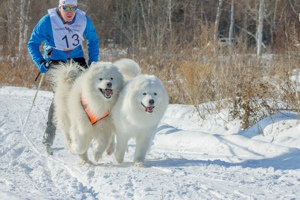Skijoring Rules

Skijoring is a winter sport where a horse, dogs or vehicle pulls a person on skis. It is unclear just where the sport originated, as forms of it appear in many parts of the world that have the right cold weather conditions to host it. However, as a competitive sport it is thought that the sport originates from Scandinavia as an offshoot from the sport of Pulka, where a toboggan is pulled by a dog, skier or reindeer. Today, the sport is done almost exclusively with dogs and the name Skijoring comes from the Norwegian word skikjøring, which is translated as ski driving.
Object of the Game
The object of Skijoring is for the skier and their team of dogs – such as Alaskan Malamutes – to work in harmony. The dogs provide power by running and pulling and the skier guides them with their voice, as well as providing extra power with their skis and poles. In races, the object is to win the race by completing the course in the quickest time possible against complexities. The sport is also practiced recreationally though where there is no objective as such, but just enjoying the activity of skijoring and working in harmony with the dogs.
Players & Equipment
The equipment needed for Skijoring is relatively basic. A skijoring belt that is worn by the skier, which is a wide waistband that clips around the waist, but may also have leg loops which are there to help keep it in place. Sometimes rock climbing harnesses are used too as belts.
The dog sled harnesses used tend to be quite generic and can be used for a variety of types of dogsled racing. Then there is the skijoring line that is used to connect the skier to the dog harness. This usually at least 1.5m long but can be longer when larger dog teams are used. Often, the lines have a section of bungee cord in their to absorb the impact of the dog’s forward motion. There are also quick release options to that enable the skier to quickly let go of the dogs.
Scoring
There is no scoring in Skijoring. It is a race in which the first over the winning line is the winner.
Winning
The winner of a Skijoring race or trial is the team that completed the course in the quickest time possible. The nose of the Lead Dog(s) shall determine the finish time of the team
Rules
Each different Skijoring competition may have slight rule variations but most will share the same fundamental rules as below:
- The starting order of a competition is usually done by means of a draw.
- Skijoring teams should consist of a maximum of three dogs and a minimum of one dog.
- Skijoring teams must be attached via harness and tow-line to the skijoring belt in a safe and secure manner, leaving the skijorers hands free of the line. The line length shall be a minimum of seven feet and a maximum of twelve feet.
- All skiers shall wear a skijoring belt that is at least 3-inches width across the back.
- All dogs must have a neckline attached apart from a dog run alone.
- The starting point of the team is determined by the tips of the skier's skis.
- If a team is overtaken, it shall not re-pass for two minutes or half a mile, except by the mutual agreement of both drivers.
- The nose of the lead dog over the finishing line determines the finish time of the team.